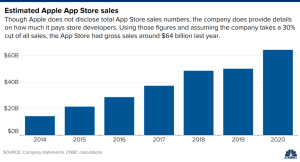As the mobile app market continues to grow, the competition in the app stores is becoming increasingly fierce. With over 5 million apps available on both the App Store and Google Play Store, it can be challenging for developers to get their apps discovered and downloaded by potential users. That’s where App Store Optimization (ASO) comes in. ASO is the process of optimizing your app’s listing in the app stores to increase visibility, downloads, and user engagement. In this article, we’ll provide you with some useful tips, tricks, and tools to help you optimize your app store listing and improve your app’s performance in 2023.
By Liz Rustia

Conduct Keyword Research
Use keyword research tools to identify relevant keywords that users are searching for in the app store. Incorporate these keywords into your app title, description, and other elements of your app listing.
Create a Compelling App Description
Your app’s description is another important aspect of ASO. Your description should be clear, concise, and provide users with an overview of what your app does and how it can benefit them. Use bullet points and short paragraphs to make your description easy to read. Be sure to include keywords in your description, but avoid keyword stuffing. Also, consider using screenshots or videos to showcase your app’s features and user interface.
Optimize Your App Icon and Screenshots
Your app’s icon is the visual representation of your app in the app store. It’s important to choose an icon that is unique, memorable, and reflects your app’s purpose. Consider using bright colors, bold typography, or an image that represents your app’s functionality. Additionally, your app’s screenshots should showcase your app’s best features and functionality. Use high-quality images and include text to highlight important features and benefits.
Monitor and Respond to User Reviews
User reviews play a significant role in the success of your app. They can influence a user’s decision to download your app, and they can also impact your app’s ranking in the app stores. It’s important to monitor user reviews and respond to them promptly. Address any issues or concerns that users have, and thank users for positive reviews. By doing so, you can improve your app’s rating and increase user engagement.
Monitor Your Competitors
Keep an eye on your competitors’ app listings to see what keywords and strategies they are using. Use this information to optimize your own app listing and stay ahead of the competition.
Use App Store Optimization Tools
There are a variety of ASO tools available that can help you optimize your app store listing and improve your app’s performance. These tools provide insights into app store data, user behavior, and marketing trends. Some of the most popular ASO tools include:
- Data.ai (Formerly App Annie): Provides insights into app store data, user behavior, and marketing trends.
- Sensor Tower: Provides insights into app store data, user behavior, and marketing trends.
- Mobile Action: Provides insights into app store data, user behavior, and marketing trends.
- Keyword Tool: Helps you find the best keywords to use in your app store listing.
- AppFollow: Helps you monitor and respond to user reviews and feedback.
- SplitMetrics: Allows you to test different versions of your app store listing to see which one performs best in terms of downloads and conversions.
- StoreMaven: Allows you to test different versions of your app store listing to see which one performs best in terms of downloads and conversions.
By using these tools, you can gain a competitive advantage and improve your app’s visibility, user acquisition, and revenue.
Implementing these ASO tips, tricks, and tools can help you improve your app’s visibility, downloads, and user engagement in the competitive app market of 2023. By staying up-to-date with the latest ASO best practices and utilizing the right tools, you can position your app for success and achieve your business goals.











